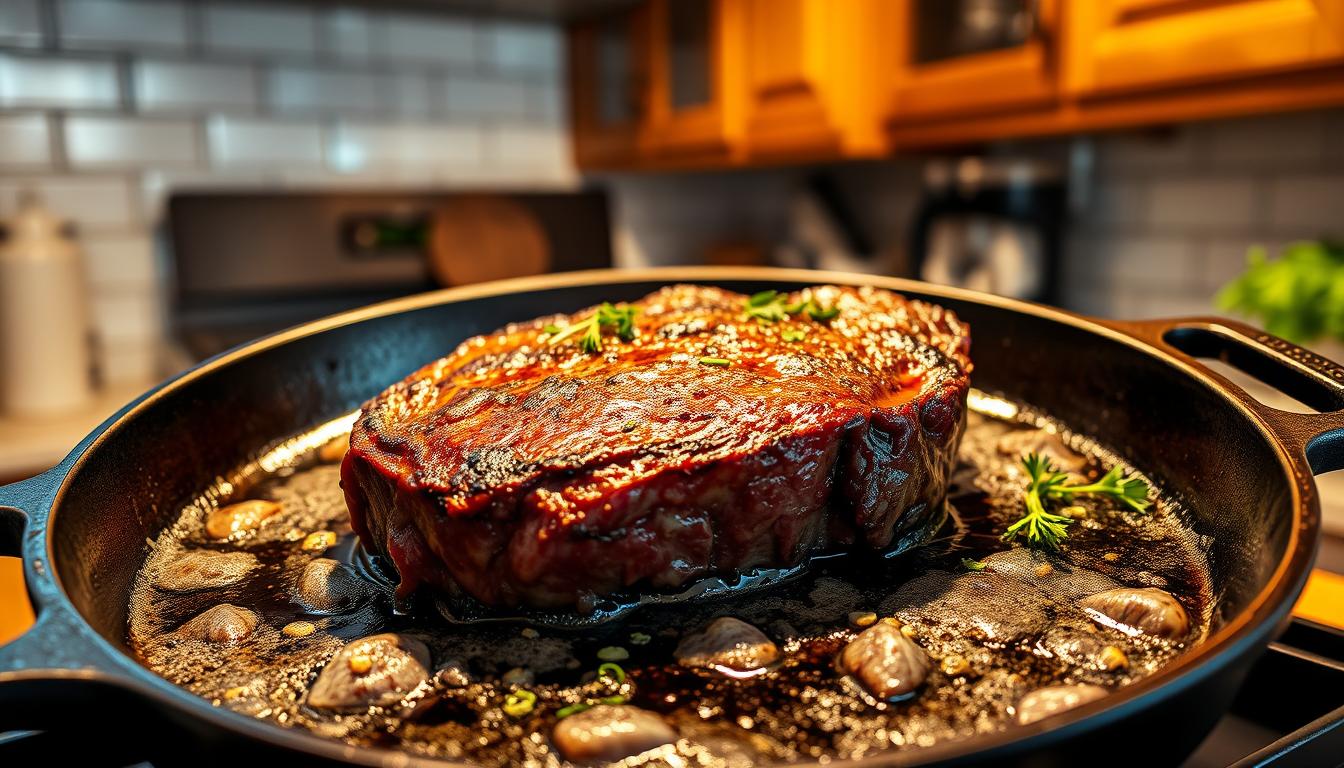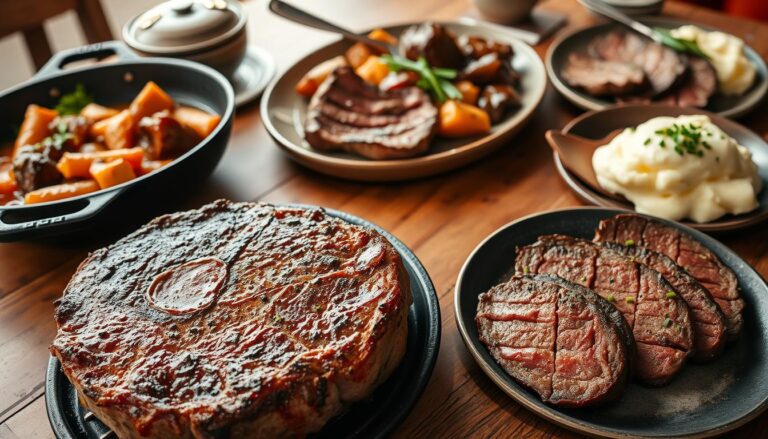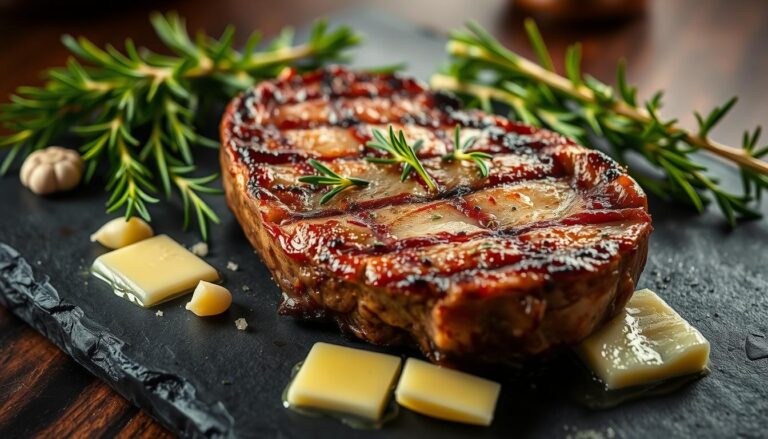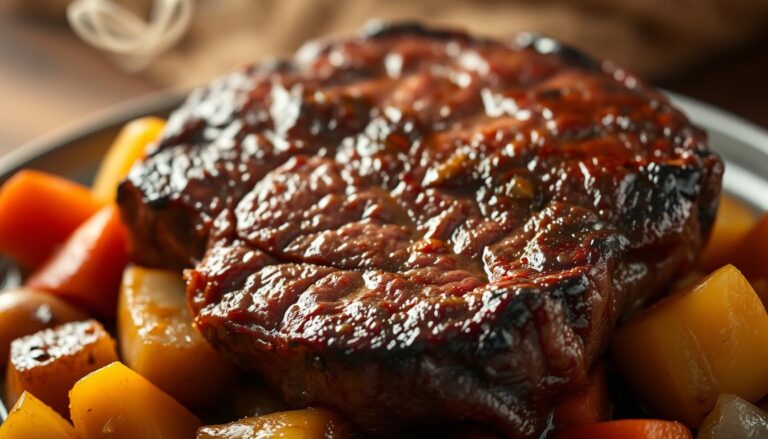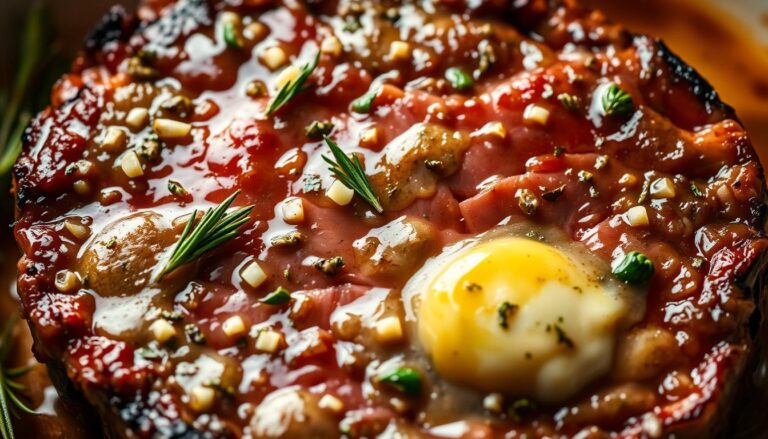Delicious Top Round Steak: Easy Prep Tips
Top Round Steak
There’s something magical about slicing into a perfectly cooked cut of beef. The aroma of garlic and herbs fills the air, and the first bite melts in your mouth like a high-end restaurant dish. But here’s the secret: you don’t need a chef’s hat to master this.
This guide unlocks restaurant-quality results right in your kitchen. Whether you’re new to cooking or looking to refine your skills, we’ll walk you through everything—from selecting the right ingredients to plating like a pro. The best part? You’ll save money without sacrificing flavor.
We’ll focus on simple techniques like searing in a skillet and basting with rich garlic-herb butter. Alternative methods are included, too, so you can adapt based on your kitchen setup. And yes, seasoning is half the battle—salt, pepper, and fresh rosemary work wonders here.
Table of Contents
Introduction: Understanding Top Round Steak
Discover the secret behind a budget-friendly cut that rivals pricier options. Round steak comes from the cow’s hind legs, making it leaner than ribeye or sirloin. While it’s less tender naturally, its bold beefy flavor shines when handled right.
What Makes This Cut Stand Out?
This lean meat acts like a flavor sponge. Marinate it with garlic, herbs, or acidic ingredients, and it soaks up every drop. Unlike fatty cuts, it won’t leave pools of grease on your plate. As chef Arman Liew notes: “Round steak’s affordability lets home cooks experiment without guilt.”
Why You’ll Love Cooking With It
Versatility is its superpower. Sear it quickly for weeknight dinners or slow-cook it for Sunday roasts. Check out how it stacks up against other popular cuts:
| Cut | Fat Content | Best Cooking Methods | Price per Pound |
|---|---|---|---|
| Round Steak | Low | Pan-searing, braising | $6-$8 |
| Ribeye | High | Grilling, broiling | $15-$20 |
| Filet Mignon | Medium | Pan-frying, roasting | $25-$30 |
See that price difference? You’re getting real beef flavor without the markup. Later sections will show you how to transform this cut into melt-in-your-mouth meals using simple techniques.
Essential Ingredients and Tools
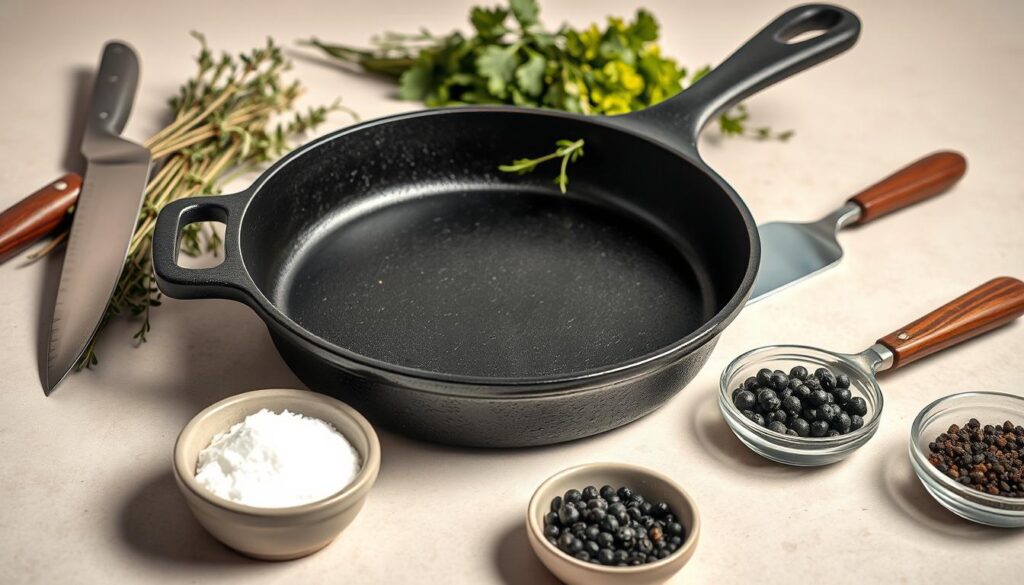
Great meals start with quality components and the right gear. For juicy, flavorful results, focus on pantry staples that amplify natural taste. Proper equipment ensures consistent heat and texture, turning simple recipes into memorable meals.
Must-Have Seasonings and Marinades
Kosher salt and cracked black pepper form the foundation. Their coarse texture clings better than fine grains, creating a crisp crust. Fresh garlic adds aromatic depth, while olive oil prevents sticking and boosts browning.
Marinades with acidic elements like lemon juice or vinegar soften the meat’s fibers. Soy sauce or Worcestershire adds umami richness. For herb-infused butter, blend rosemary or thyme into softened unsalted varieties. This melts evenly over the cooked dish.
Recommended Skillets and Cooking Equipment
A cast iron skillet is non-negotiable. Its heavy base distributes heat evenly, preventing hot spots. Chef Emma Chapman advises: “A well-seasoned skillet develops a natural non-stick surface ideal for searing.” Oven-safe models let you finish cooking under broilers.
Stainless steel pans work if you lack cast iron. Avoid non-stick coatings, which hinder crust formation. Pair your skillet with tongs for flipping and a meat thermometer for precision. A ceramic dish works for marinating or resting meat after cooking.
Invest in fresh ingredients and durable tools. Your kitchen arsenal should simplify the process, not complicate it. With these essentials, even weeknight dinners feel elevated.
How to prepare top round steak: Expert Step-by-Step Guide
Transforming lean cuts into tender masterpieces hinges on methodical preparation. Follow this roadmap to elevate your culinary game while keeping flavors bold and textures satisfying.
Prepping and Tenderizing the Steak
Place your cut beef between parchment sheets. Gently pound with a meat mallet until uniformly thin this breaks down tough fibers. Chef Michael Sullivan advises: “Aim for consistent thickness to ensure even cooking.”
Pat the meat dry with paper towels. Generously rub both sides with kosher salt and cracked pepper. Let it rest at room temperature for 20 minutes while preheating your cast iron pan.
Step-by-Step Cooking Instructions
Heat the skillet over medium-high until oil shimmers. Sear the round steak 4 minutes per side for a caramelized crust. Reduce heat to medium, then add butter, crushed garlic, and rosemary sprigs.
Tilt the skillet, spooning melted butter over the meat continuously for 2 minutes. Use a digital thermometer—remove at 130°F for medium-rare. Rest 8 minutes before slicing.
Always cut against the grain using a sharp knife. This shortens muscle fibers, making each bite exceptionally tender. Pair with roasted vegetables or mashed potatoes for a complete steak recipe experience.
Cooking Techniques and Methods
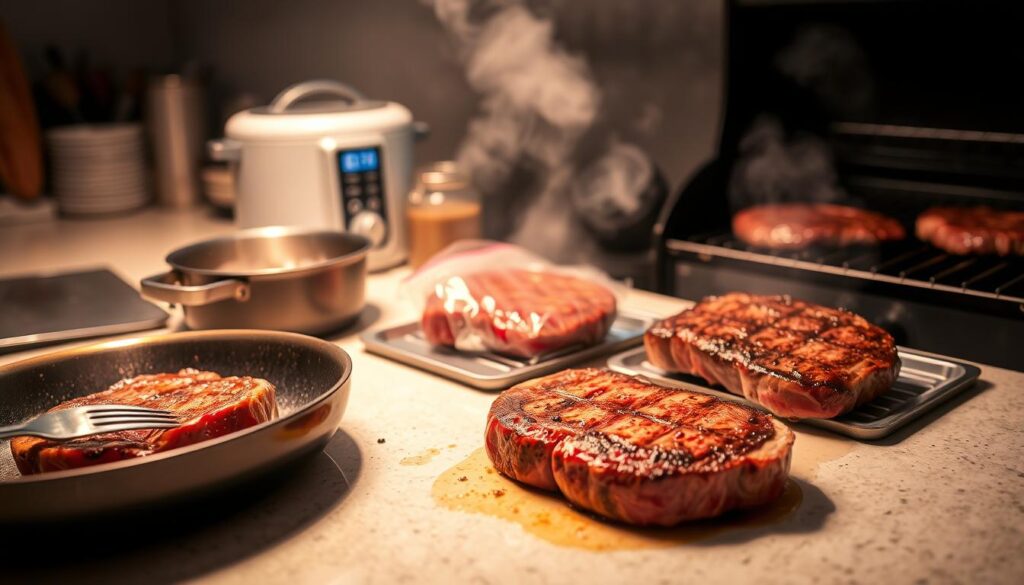
Unlocking your steak’s full potential starts with choosing the right cooking method. Each technique from sizzling skillet sears to smoky grill marks—creates distinct textures and flavor profiles. Your equipment and schedule determine which approach works best for your kitchen.
Pan-Searing and Skillet Tips
A cast iron skillet reigns supreme for quick, crusty perfection. Preheat it over medium-high heat until water droplets dance on the surface. Sear steaks 4-5 minutes per side, flipping once. Chef Carla Martinez notes: “That initial sizzle locks in juices better than any other method.”
Non-stick pans work but won’t deliver the same caramelization. Always pat meat dry before adding it to the hot pan. For even cooking, avoid overcrowding leave space between pieces.
Oven, Grill, and Air Fryer Alternatives
Oven roasting suits busy schedules. Set to 275°F and cook 2-3 hours for fall-apart tenderness. Grilling over direct heat (450°F) gives charred edges in 5-7 minutes per side. Air fryers? They crisp surfaces at 400°F in 12-15 minutes with minimal oil.
Each method shines in specific scenarios:
- Skillet: Weeknight dinners needing speed
- Grill: Summer gatherings with smoky flair
- Oven: Hands-off weekends
Match your tool to the occasion. Your taste buds—and schedule—will thank you.
Tips and Tricks for a Tender, Flavorful Steak
The difference between good and great often comes down to a few key tricks. These methods turn basic meals into memorable dinners your family will request again. Let’s dive into techniques that amplify tenderness and flavor without complicating your routine.
Effective Marinating and Seasoning Methods
Marinate your round steak overnight in acidic ingredients like lemon juice or yogurt. This softens fibers while infusing deep taste. For quick results, rub kosher salt into the meat 40 minutes before cooking. Chef Lisa Nguyen confirms: “Salt acts like a natural tenderizer it’s a game-changer for lean cuts.”
Control Temperature and Timing Like a Pro
Use a digital thermometer to avoid guesswork. Remove the steak from heat at 125°F for rare or 135°F for medium. Let it rest 8-10 minutes—this allows juices to redistribute. Temperature spikes can toughen meat, so keep your skillet at medium-high.
Herbs and Butter: The Flavor Boosters
Melt garlic-herb butter during the last 2 minutes of cooking. Baste continuously for a glossy, aromatic crust. Combine softened butter with rosemary or thyme for extra depth. A drizzle of olive oil before searing ensures even browning.
Small adjustments create big results. Resting meat properly adds juiciness, while fresh herbs elevate simple seasoning. With these tips, your next dinner will rival any steakhouse experience.
Serving Suggestions and Ideal Side Dishes
Pairing your meal with thoughtful sides transforms dinner into an experience. The right combinations balance textures and flavors while adding visual appeal. Let’s explore options that complement bold beef profiles without overshadowing them.
Complementary Sides to Elevate Your Meal
Classic mashed potatoes absorb pan juices beautifully. For a lighter option, try garlic-roasted asparagus or honey-glazed carrots. Crisp salads with tangy vinaigrettes cut through richness. Food blogger Jenna Weber suggests: “A chimichurri drizzle adds fresh herb brightness to hearty dishes.”
| Side Dish | Prep Time | Flavor Profile | Pairing Tip |
|---|---|---|---|
| Garlic mashed potatoes | 25 minutes | Creamy, savory | Top with peppercorn sauce |
| Balsamic Brussels sprouts | 20 minutes | Sweet, tangy | Add toasted walnuts |
| Quinoa salad | 15 minutes | Fresh, zesty | Toss with lemon dressing |
Plating and Presentation Ideas
Slice meat against the grain and fan across warm plates. Place sides in small mounds for height contrast. Drizzle olive oil around the plate’s edge for professional flair. Warm serving dishes in the oven 5 minutes before plating—this keeps food hot longer.
Garnish with rosemary sprigs or edible flowers. Use colorful vegetables like roasted peppers or purple potatoes. Chef Marco Pierre White advises: “White space on the plate lets each element shine.” Time side dishes to finish cooking as the steak rests.
Experiment with modern twists—try polenta fries instead of mashed potatoes. Or serve with charred corn salsa for summer BBQs. The key lies in balancing flavors and textures while making every plate Instagram-worthy.
Conclusion
Turning everyday ingredients into restaurant-worthy meals is simpler than you think. By selecting quality beef, mastering heat control, and using bold seasoning, even lean cuts become tender triumphs. Remember: proper resting lets juices settle, while cast iron skillets deliver that golden crust every time.
Whether pan-searing with garlic butter or experimenting with grill techniques, this recipe adapts to your kitchen. Marinate overnight for deeper flavor, and always slice against the grain. These small steps make big differences at the family table.
Ready to shine? Whip up this dish, snap a photo, and tag #BeefMastery on social media. Your next dinner proves gourmet results don’t require fancy tools—just smart methods. Now grab that skillet and let your kitchen confidence sizzle!

